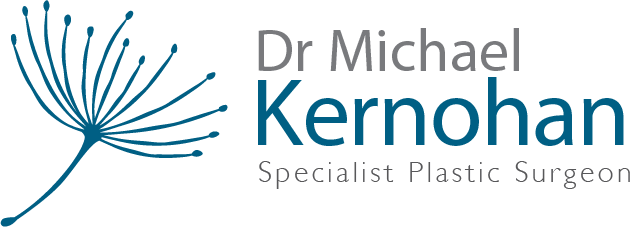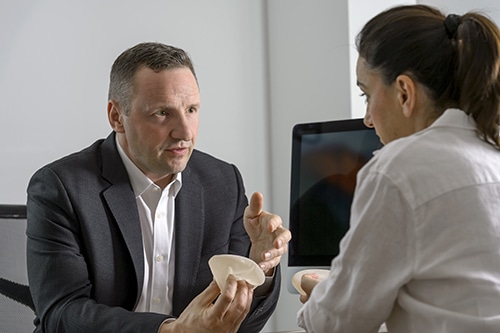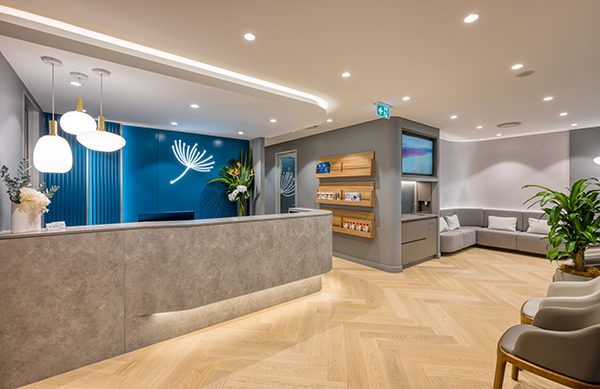What to Expect and How to Manage Breast Lift (Mastopexy) Scars for Optimal Results
- Are you planning to get breast lift (mastopexy) surgery?
- Would you like to know what types of scars can you expect after the procedure?
- Do you want to know more about the scars healing process?
Breast lift/Mastopexy surgery aims to improve the appearance of sagging breasts by reshaping and lifting them. However, like any surgical procedure, breast lift surgery comes with some potential side effects, with one of the most notable being breast lift scars.
As you consider breast lift surgery, it’s essential to familiarise yourself with the various incision techniques and what to expect in terms of scarring. This blog will explore the different types of breast lift/mastopexy incisions, why scars occur, factors that can influence their appearance, and tips and treatments for minimising and managing breast lift scars.
Specialist Plastic Surgeon Dr Michael Kernohan regularly performs breast lift/mastopexy surgeries. Throughout the entire process, from consultation to post-operative care, Dr Kernohan demonstrates exceptional attention to detail and a deep understanding of the nuances involved in breast lift procedures.
Take the Quiz
Types of Breast Lift/Mastopexy Incisions
There are several different techniques for breast lift/Mastopexy surgery, each involving different incision patterns. The incision type used will depend on factors such as the degree of sagging, breast size and shape, and the surgeon’s preference. Here are the four most common types of breast lift/mastopexy incisions:
- Crescent lift: This technique involves a small, crescent-shaped incision made along the upper half of the areola. It is typically used for patients with minimal sagging, as it allows for only a slight lift
- Periareolar or “donut” lift: This method involves a circular incision made around the entire edge of the areola. This technique is suitable for patients with mild to moderate sagging and can also be used to reduce areola size
- Vertical or “lollipop” lift: In this technique, an incision is made around the areola and extends vertically down to the breast crease, creating a lollipop shape. This approach is suitable for patients with moderate sagging and provides a more significant lift than the periareolar method
- Inverted-T or “anchor” lift: This method involves an incision around the areola, a vertical incision down to the breast crease, and a horizontal incision along the breast crease, creating an anchor shape. This technique is used for patients with significant sagging and provides the most substantial lift
What Are Breast Lift Scars And Why Do They Occur?
Breast lift scars are the result of the body’s natural healing process after incisions have been made in the skin during surgery. When the skin is cut or damaged, the body produces collagen to repair the wound. This collagen forms a scar, which will initially appear red or dark and raised but will gradually fade and flatten over time.
Scarring is a normal part of the healing process and an inevitable consequence of breast lift/mastopexy surgery. However, the extent and appearance of scarring can vary depending on factors such as the incision technique used, your skin type, and how well you care for your incisions during the healing process. With proper care and management, it is possible to minimise the appearance of breast lift/mastopexy scars and achieve optimal results.
Factors Affecting the Appearance of Breast Lift?Mastopexy Scars
Several factors can influence the appearance of breast lift scars, including:
- Incision technique: As mentioned earlier, some incision techniques result in more extensive scarring than others. For example, the anchor lift method, which involves three incisions, will generally result in more noticeable scarring than the crescent lift, which involves only a single, small incision
- Skin type: Your skin type can also play a role in how your scars heal and appear. Individuals with darker skin tones are more prone to developing keloid or hypertrophic scars, which are raised, thick, and sometimes painful
- Genetics: Your genetic makeup can also influence your scarring. Some people are more prone to developing noticeable scars due to their family history
- Age: Older people may experience a slower cicatrisation process and even more visible scarring, as the skin loses elasticity and collagen production decreases with age
- Lifestyle factors: Smoking, poor nutrition, and excessive sun exposure can negatively impact the healing process and contribute to more noticeable scarring
- Post-operative care: How you care for your incisions after surgery plays a significant role in the healing process and the appearance of your scars
Click to Download Dr Michael Kernohan Cosmetic Breast Surgery Guide

Tips for Minimising Breast Lift/Mastopexy Scars
To achieve the best possible outcome and minimise the appearance of breast lift scars, consider the following tips:
Choose a skilled surgeon
Selecting an experienced, specialist plastic surgeon who performs breast lift/Mastopexy surgery routinely is crucial for minimising scarring. A skilled surgeon will use precise techniques and place incisions in inconspicuous locations to reduce the visibility of scars.
Follow post-operative instructions
Adhering to your surgeon’s post-operative care instructions is essential for proper healing and minimising scarring. This may include avoiding certain activities, wearing a compression garment, and properly cleaning and caring for your incisions.
Avoid sun exposure
Excessive sun exposure can cause scars to darken and become more noticeable. Keep your incisions protected from the sun, especially during the first year after surgery, by wearing sunscreen and covering the area with clothing.
Maintain a healthy lifestyle
Eating a balanced diet, staying hydrated, and avoiding smoking can promote better healing and minimise scarring. Additionally, maintaining a stable weight can help prevent additional sagging and stretching of the skin, which could worsen scarring.
Be patient
Scarring is a natural part of the healing process, and it takes time for scars to mature and fade. Keep in mind that it may take up to a year or more for your scars to reach their final appearance.
Treatments for Breast Lift/Mastopexy Scar Management

If you’re concerned about the appearance of your breast lift/mastopexy scars, several treatments can help improve their appearance:
- Silicone sheets and gels: Silicone products, such as sheets and gels, can help flatten and fade scars by providing consistent pressure and hydration to the scar tissue. These products are typically used for several months after surgery and can be effective in reducing the appearance of scars
- Steroid injections: In some cases, steroid injections can help reduce the size and thickness of raised scars, such as keloids or hypertrophic scars. This treatment should only be performed by a qualified healthcare professional
- Laser therapy: Laser treatments can help improve the texture, colour, and appearance of scars by stimulating collagen production and breaking down scar tissue. Several sessions may be required to achieve the desired results, and the treatment should be performed by a qualified professional
- Microneedling: Microneedling involves using a device with tiny needles to create micro-injuries in the skin, which stimulates collagen production and can help improve the appearance of scars. This treatment should be performed by a qualified professional
- Surgical revision: In some cases, surgical revision may be necessary to improve the appearance of breast lift/mastopexy scars. This may involve removing the scar tissue and re-closing the incision using improved techniques. This option should be discussed with your surgeon and considered only after other treatments have been tried
The Role of Post-Operative Care In Incisions Healing
Proper post-operative care is crucial for promoting optimal incisions healing and minimising the appearance of breast lift/mastopexy scars. Here are some key aspects of post-operative care to keep in mind:
- Cleanliness: Keep your incisions clean and dry to reduce the risk of infection, which could worsen scarring. Follow your surgeon’s instructions for cleaning the incision area and changing dressings
- Compression garments: Your surgeon may recommend wearing a compression garment or supportive bra after surgery to reduce swelling and provide support to the healing tissues. This can help promote better healing and minimise scarring
- Activity restrictions: Follow your surgeon’s recommendations for activity restrictions, such as avoiding heavy lifting, strenuous exercise, and certain movements that could put stress on your incisions. This will help prevent complications and promote proper healing
- Scar massage: Gently massaging your scars once they have healed can help improve their appearance by breaking down scar tissue and promoting blood flow to the area. Talk to your surgeon about when and how to perform scar massage
Breast lift/Mastopexy scars are an inevitable part of the healing process after surgery, but there are steps you can take to minimise their appearance and achieve optimal results. By choosing a skilled surgeon, following post-operative instructions, maintaining a healthy lifestyle, and considering treatments for scar management, you can achieve an optimal outcome.
It’s also important to remember that scarring is a natural part of the healing process and that it takes time for scars to mature and fade. Be patient and follow your surgeon’s recommendations to ensure proper healing and minimise the risk of complications.
FAQs about Breast Lift/Mastopexy Surgery

Do breast lift/mastopexy scars go away?
- Breast lift scars do not completely disappear, but their appearance usually improves significantly over time. After a breast lift procedure, scarring is a natural part of the healing process as the incisions made during surgery close and heal. As the healing progresses, the scars fade, becoming less noticeable, but they will not vanish entirely. Factors such as genetics, skin type, and post-operative care can impact the final appearance of scars, with some individuals experiencing better results than others. Following your surgeon’s instructions for post-operative care and considering options like silicone sheets, gels, or creams can help to minimise the visibility of scars.
Does a breast lift/mastopexy leave big scars?
- The size of scars resulting from a breast lift can vary depending on the surgical technique used and the extent of the lift required. There are several types of breast lift procedures, each with different incision patterns. Some result in minimal scarring, while others may leave more extensive scars. Surgeons aim to place incisions in certain areas to minimise visibility. It is important to discuss the type of incisions and potential scarring with your surgeon before undergoing the procedure to understand what to expect in terms of scarring.
How painful is breast lift/mastopexy?
- The level of pain experienced after a breast lift varies between individuals, as each person has a unique pain tolerance. Some discomfort and swelling are normal in the initial days following the procedure. Most patients report that pain is manageable with prescribed pain medications. Following your surgeon’s post-operative care instructions and taking medication as directed can help minimise discomfort during the healing process. Pain and discomfort decrease within the first week, with most patients returning to daily activities within a few weeks.
Will my breasts sag again after lift?
- While a breast lift can significantly improve the appearance of sagging breasts, it cannot entirely prevent future sagging. Factors such as aging, gravity, weight fluctuations, and hormonal changes can continue to impact the shape and position of the breasts over time. However, the results of a breast lift can be long-lasting. Many patients enjoying the improved appearance of their breasts for several years. To maintain the best possible results, it is crucial to maintain a stable weight, exercise regularly, and wear supportive bras. In some cases, a revision surgery may be needed to address changes in breast shape or position.
Further Reading about Breast Lift with Dr Kernohan
- Read Dr Kernohan’s Breast Lift Surgery Page
- Read Dr Kernohan’s Breast Lift with Implants Surgery Page
- Read Dr Kernohan’s Blog about Solutions for Saggy Breasts – Augmentation, Lift or Reduction
- Read Dr Kernohan’s Blog about How to Get Firmer Breasts
- Read Dr Kernohan’s Blog about Will Medicare cover my surgery?
- Read Dr Kernohan’s blog Will Medicare Cover My Breast Lift Surgery?






